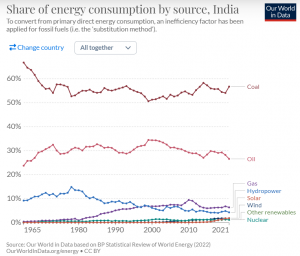
As the world grapples with the impact of climate change, national governments are embracing green energy initiatives and carbon reduction strategies. India, too, has been making remarkable progress in green energy transition. Recognising India’s efforts towards decarbonising its economy, the United States has stepped in to help its ally speed up its energy transition. US treasury secretary Janet Yellen on Monday announced a collaboration aimed at developing an investment platform that will bolster India’s renewable energy drive.
The two countries have underscored the importance of joint action and collaboration which will not only help bilateral ties but also play a key role in the global energy transition as these countries are among the three heaviest polluters. The proposed platform will deliver in terms of lower cost of capital and higher private investment to speed India’s energy transition, Yellen said in a joint statement with Union finance minister Nirmala Sitharaman on the sidelines of a G20 meeting. The goal is to improve access to reliable, affordable, and clean energy supply.
Deliberations have also been made towards cooperating on achieving targets in advanced research, development and commercialisation of technologies in the emerging fuels such as bio-ethanol, renewable diesel, sustainable aviation fuels, and other advanced biofuels.
READ | Geographical indications: Boosting exports, driving prosperity
India’s green energy transition
While it is of utmost importance for all the countries to adopt clean energy as soon as possible to avoid the catastrophic effects of global warming, India faces the additional challenge of lifting the standard of living of its population and preparing them for what is inevitable. The country is already facing the effects of climate change and has witnessed severe heat strokes and water shortage in recent years.

As the world’s most populous nation, what India does in the next few years will be of supreme importance. In view of this, it is heartening that the government has been taking the need for green energy transition seriously. In fact, it was in May this year that the new National Electricity Plan (NEP) was launched which shows that the government means business when it comes to India’s green transition.
India has scaled up its renewable energy capacity by 250% between 2014 and 2021 and now ranks fourth in renewable energy capacity in the world. With a focus on investing in energy efficiency, expanding renewable energy generation, and the use of green hydrogen for energy storage, India hopes that it will be able to reduce its dependency on fossil fuels in the medium term.
The government has plans to introduce solar cities and parks, while work is underway on the National Green Hydrogen Mission, and the Green Energy Corridor. Other schemes to incentivise green energy adoption such as the production-linked incentive (PLI) scheme for entities that set up manufacturing facilities for clean technology are also in place.
India is an energy guzzler and the demand for electric power is bound to go up with economic development. Its present energy consumption per capita is just about a third of the global average. This calls for a phasing down fossil-based energy sources, especially in the light of India’s goal of achieving net zero by 2070.
To be consistent with climate sustainability, India must ensure that a higher proportion of the energy mix is green i.e., coming from renewable sources. India currently has about 400 Gigawatts (GW) of electric power capacity, of which about 53% is based on coal (and lignite), and around 25% from solar and wind. The renewables account for 37.5% of the total capacity. However, over 70% of actual power generation still comes from coal.
The government looks to reverse the current situation and if the NEP’s goals for the next decade are achieved, the figures will be 29% coal and 64% renewables, with solar on its own accounting for 40% of the total, or well over half of the renewables contribution.
Funding the green energy transition
The World Bank recently approved $1.5 billion in finance to accelerate India’s development of low-carbon energy. The financing will be deployed towards scaling up renewable energy, developing green hydrogen, and stimulating climate finance for low-carbon energy investments.
The World Bank recognises that mere public sector funding cannot support India’s energy transition and there is a need for the private sector and other organisations to build on recent successes. The multilateral funder hopes that its funding pledge will attract private sector finance. With the First Low-Carbon Energy Programmatic Development Policy Operation by the World Bank, the organisation hopes that the successful implementation of the National Green Hydrogen Mission, which aims to stimulate $100 billion in private sector investment by 2030, will be supported.
While the country goes on to attract funding, it will also need to tackle many challenges on the way. These include access to affordable financing, lack of institutions that can deploy financing effectively in new low-carbon growth areas, technology risks and ensuring a just transition. However, considering India’s current momentum, the world is hopeful that India is set to leave a mark on global efforts towards green energy transition.
